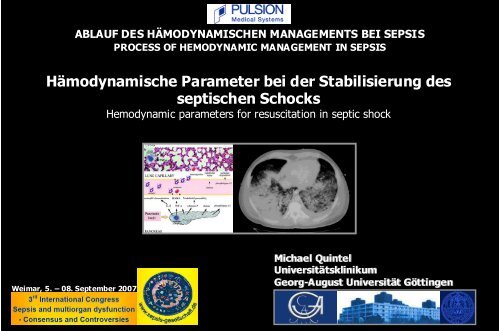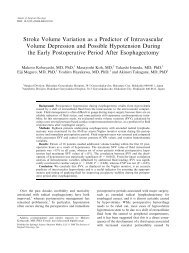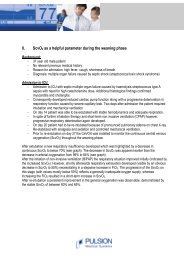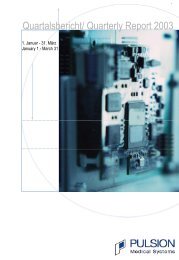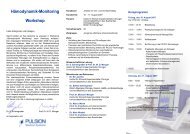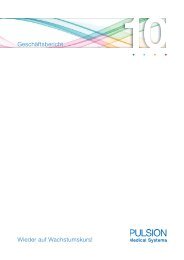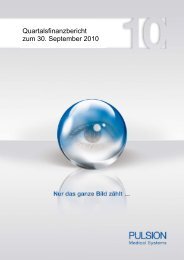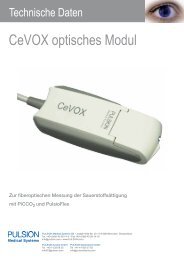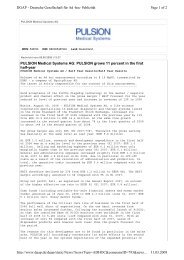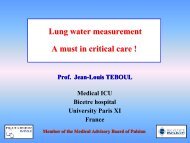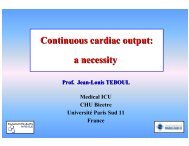Hemodynamic parameters for resuscitation in septic shock
Hemodynamic parameters for resuscitation in septic shock
Hemodynamic parameters for resuscitation in septic shock
You also want an ePaper? Increase the reach of your titles
YUMPU automatically turns print PDFs into web optimized ePapers that Google loves.
ABLAUF DES HÄMODYNAMISCHEN MANAGEMENTS BEI SEPSIS<br />
PROCESS OF HEMODYNAMIC MANAGEMENT IN SEPSIS<br />
Hämodynamische Parameter bei der Stabilisierung des<br />
septischen Schocks<br />
<strong>Hemodynamic</strong> <strong>parameters</strong> <strong>for</strong> <strong>resuscitation</strong> <strong>in</strong> <strong>septic</strong> <strong>shock</strong><br />
Weimar, 5. – 08. September 2007<br />
Michael Qu<strong>in</strong>tel<br />
Universit Universitätskl<strong>in</strong>ikum<br />
tskl<strong>in</strong>ikum<br />
Georg Georg-August August Universit Universität t GGött<strong>in</strong>gen<br />
Gött<strong>in</strong>gen tt<strong>in</strong>gen
Advanced hemodynamic monitor<strong>in</strong>g:<br />
cl<strong>in</strong>ical picture:<br />
hemodynamic <strong>in</strong>stability<br />
oligo-anuria<br />
lactate acidosis<br />
high airway pressures<br />
when and how?<br />
volume status:<br />
BP-trac<strong>in</strong>g,<br />
chest X ray,<br />
fluid balance<br />
hemoglob<strong>in</strong><br />
centralisation<br />
ventilation:<br />
mean airway pressure,<br />
tidal volume,<br />
respiratory frequency<br />
therapeutic options:<br />
volume therapy or<br />
negative fluid balance<br />
transfusion (Hb < 7,5 g/dl ? )<br />
catecholam<strong>in</strong>es<br />
optimization of ventilation
Start with a Subjective Assessment of Sk<strong>in</strong> Temperature to Identify<br />
Hypoperfusion <strong>in</strong> Intensive Care Unit Patients<br />
Kaplan LJ, et al. J Trauma 2001; 50: 620-7<br />
Cold extremities = Hypoperfusion: 39% pos. pred.<br />
Cold extr. + low HCO 3 = Hypoperfusion: 98% pos. pred.
VO 2<br />
• stress<br />
• pa<strong>in</strong><br />
• hyperthermia<br />
• shiver<strong>in</strong>g<br />
• work of<br />
breath<strong>in</strong>g<br />
-<br />
SvO2 oder ScvO 2<br />
DO 2<br />
• PaO2<br />
• Hgb<br />
• cardiac<br />
output<br />
70%<br />
DO 2<br />
• PaO2<br />
• Hgb<br />
• cardiac<br />
output<br />
+<br />
VO 2<br />
• hypothermia<br />
• anesthesia<br />
• decrease<br />
work of<br />
breath<strong>in</strong>g
Non-<strong>in</strong>vasively: cl<strong>in</strong>ical signs<br />
HR - MAP<br />
capillary refill<br />
ur<strong>in</strong>e output<br />
core - peripheral temperature difference<br />
• moderate bleed<strong>in</strong>g<br />
• sensitivity: 22% (95% CI: 6-48%)<br />
McGee et al. JAMA 1999; 281:1022
cl<strong>in</strong>ical picture:<br />
high airway pressures<br />
hemodynamic <strong>in</strong>stability<br />
oligo-anuria<br />
lactate acidosis<br />
Advanced monitor<strong>in</strong>g:<br />
when and how?<br />
advanced monitor<strong>in</strong>g<br />
volume status:<br />
BP-trac<strong>in</strong>g, ITBVI,<br />
EVLWI a.s.o.<br />
(PCWP, CVP, chest xray,<br />
fluid balance<br />
hemoglob<strong>in</strong><br />
centralisation,<br />
SVR, HZV, PDR, UO<br />
ventilation:<br />
mean airway<br />
pressure, tidal<br />
volume, respiratory<br />
frequency<br />
SvO 2 , ScvO 2<br />
DO 2 , VO 2<br />
PaP, PVR<br />
therapeutic options:<br />
volume therapy or<br />
negative fluid balance<br />
transfusion (Hb < 7,5 g/dl ?)<br />
catecholam<strong>in</strong>es<br />
optimization of ventilation<br />
prostacycl<strong>in</strong>e <strong>in</strong>halation, NO
6 8 12 14 16 18 20 22 24 26 28 30 ml/kg BW<br />
volume load<br />
EVLWI <strong>for</strong> "guidance" of volume therapy<br />
catecholam<strong>in</strong>es<br />
volume restriction<br />
negative fluid balance
Fluids improves outcome<br />
"Early Goal-Directed Therapy" (EGDT)<br />
Rivers E et al. N Engl J Med 2001; 345: 1368<br />
6 hours of <strong>resuscitation</strong> <strong>in</strong> the ER:<br />
– control group (n=133):<br />
• O 2<br />
• CVP: 8-12 mmHg<br />
• MAP >65 mmHg<br />
– EGDT group (n=130):<br />
• same<br />
• ScvO 2 > 70%<br />
• more fluids, RBC<br />
• more dobutam<strong>in</strong>e<br />
mortality: 46 vs. 30% (p=0.009)
elative reduction of mortality: 34,4%<br />
Rivers E, Nguyen B, Havstad S, Ressler J, Muzz<strong>in</strong> A, Knoblich B, Peterson E, Tomlanovich M <strong>for</strong><br />
the early goal-directed therapy collaborative group.<br />
Early goal-directed therapy <strong>in</strong> the treatment of severe sepsis and <strong>septic</strong> <strong>shock</strong>.<br />
N Engl J Med 2001; 345:1368-1377
Fluids may be harmful: the SOAP study<br />
V<strong>in</strong>cent JL, et al. Crit Care Med 2006; 34: 344–353
Rivers EP.<br />
Fluid-management strategies <strong>in</strong> acute lung<br />
<strong>in</strong>jury--liberal, conservative, or both?<br />
N Engl J Med 2006; 354:2598-600
Rivers EP.<br />
Fluid-management strategies <strong>in</strong> acute lung<br />
<strong>in</strong>jury--liberal, conservative, or both?<br />
N Engl J Med 2006; 354:2598-600
DO 2= (SV • P) • (Hb • 1.39 • SaO 2+0.003 • PaO 2) ~ 1000ml/m<strong>in</strong><br />
VO 2 = CO • (CaO 2 - CvO 2 ) ~ 250 ml/m<strong>in</strong> (ScvO 2 ~70-75%)<br />
<strong>in</strong> the critically ill:<br />
Basic physiology<br />
<strong>in</strong> <strong>shock</strong> = VO 2 > DO 2<br />
CO CaO 2<br />
DO 2<br />
VO 2
Hypovolaemia and DO 2<br />
DO 2 = CO • CaO 2<br />
CO = SV • P<br />
First th<strong>in</strong>g to do <strong>in</strong> hypovolemia:<br />
oxygen<br />
fluids
VO 2<br />
Oxygen Delivery<br />
volume status,<br />
contractility,<br />
π • ΔP • r 4<br />
8 • η • l<br />
DO 2<br />
CO • CaO2 VO 2<br />
temperatue analgesia, sedation<br />
Hb • 1.39 • O 2-Sat.<br />
+<br />
0.003 • paO 2
Mauermann WJ, Nemergut EC.<br />
The Anesthesiologist’s Role <strong>in</strong> the Prevention of Surgical Site Infections<br />
Anesthesiology 2006; 105:413–21
Proportion Surviv<strong>in</strong>g<br />
Connors AF et al.: JAMA 1996<br />
SUPPORT: The effectiveness of right heart<br />
catheterization <strong>in</strong> the <strong>in</strong>itial care of critically<br />
ill patients<br />
1,0<br />
0,9<br />
0,8<br />
0,7<br />
0,6<br />
p=0.02<br />
0 5 10 15 20 25 30<br />
Follow-up Time [d]<br />
No RHC<br />
RHC
SUPPORT: The effectiveness of right heart catheterization <strong>in</strong><br />
the <strong>in</strong>itial care of critically ill patients<br />
with PAC without PAK<br />
• 30 d mortality 37,5% 32,8%<br />
• 180 d mortality 54,0% 48,8%<br />
• ICU stay 14,8 d 13,0 d<br />
• costs [$] 49.300 35.700<br />
• highest catheter-associated „risik" <strong>in</strong> postoperative less seroius ill patients<br />
Connors AF et al.: JAMA 1996
Pulmonary Artery Catheter <strong>in</strong> <strong>shock</strong> and ARDS<br />
Richard C. et al (2003) JAMA 26:2713-2720
Malbra<strong>in</strong> ML.<br />
Is it wise not to th<strong>in</strong>k about <strong>in</strong>traabdom<strong>in</strong>al hypertension <strong>in</strong> the ICU?<br />
Curr Op<strong>in</strong> Crit Care 2004; 10:132-45
Kubitz JC, Kemm<strong>in</strong>g GI, Schultheiss G, Starke J, Podtschaske A, Goetz AE, Reuter DA.<br />
The <strong>in</strong>fluence of PEEP and tidal volume on central blood volume.<br />
Eur J Anaesthesiol 2006; 23:954-61
Kubitz JC, Kemm<strong>in</strong>g GI, Schultheiss G, Starke J, Podtschaske A, Goetz AE, Reuter DA.<br />
The <strong>in</strong>fluence of PEEP and tidal volume on central blood volume.
Crit Care Med 2005; 33:1119–1122<br />
a) the risks are ma<strong>in</strong>ly due to <strong>in</strong>sertion of a central catheter, not a pulmonary artery catheter<br />
b) cont<strong>in</strong>uous monitor<strong>in</strong>g of left ventricular fill<strong>in</strong>g pressures, pulmonary vascular pressures, and<br />
mixed venous oxygen saturation is a unique feature<br />
c) additional costs are m<strong>in</strong>imal relative to the cost of <strong>in</strong>tensive care<br />
d) measurement errors require ongo<strong>in</strong>g programmatic educational ef<strong>for</strong>ts<br />
e) pulmonary artery catheter-derived data need to be used with<strong>in</strong> the context of a def<strong>in</strong>ed<br />
treatment protocol<br />
f) no monitor<strong>in</strong>g device, no matter how simple or sophisticated, will improve patient-centered<br />
outcomes unless coupled with a treatment that, itself, improves outcome.
National Heart, Lung, and Blood Institute Acute Respiratory Distress Syndrome (ARDS) Cl<strong>in</strong>ical Trials Network;<br />
Wheeler AP, Bernard GR, Thompson BT, Schoenfeld D, Wiedemann HP, deBoisblanc B, Connors AF Jr, Hite RD, Harab<strong>in</strong> AL.<br />
Pulmonary-artery versus central venous catheter to guide treatment of acute lung <strong>in</strong>jury.<br />
N Engl J Med 2006; 354(21):2213-24
National Heart, Lung, and Blood Institute Acute Respiratory Distress Syndrome (ARDS) Cl<strong>in</strong>ical Trials Network;<br />
Wheeler AP, Bernard GR, Thompson BT, Schoenfeld D, Wiedemann HP, deBoisblanc B, Connors AF Jr, Hite RD, Harab<strong>in</strong> AL.<br />
Pulmonary-artery versus central venous catheter to guide treatment of acute lung <strong>in</strong>jury.<br />
N Engl J Med 2006; 354(21):2213-24
National Heart, Lung, and Blood Institute Acute Respiratory Distress Syndrome (ARDS) Cl<strong>in</strong>ical Trials Network;<br />
Wheeler AP, Bernard GR, Thompson BT, Schoenfeld D, Wiedemann HP, deBoisblanc B, Connors AF Jr, Hite RD, Harab<strong>in</strong> AL.<br />
Pulmonary-artery versus central venous catheter to guide treatment of acute lung <strong>in</strong>jury.<br />
N Engl J Med 2006; 354(21):2213-24
Static measures <strong>in</strong> critical illness<br />
Lichtwarck -Aschoff et al,<br />
Intensive Care Med 1992;<br />
18:142-7
Static measures <strong>in</strong> critical illness<br />
r=0.1<br />
ITBV<br />
r=0.66<br />
r=0.06<br />
Sakka SG et al.,<br />
J Crit Care 1999;<br />
14:78-83
AUC=0.870<br />
Volume responsiveness<br />
Predictors of <strong>in</strong>crease <strong>in</strong> SV by >5% after volume load<strong>in</strong>g<br />
AUC=0.493<br />
AUC=0.593<br />
AUC=0.729<br />
Berkenstedt H et al., Anesth Analg 2001; 92:984-9
CI and preload <strong>parameters</strong><br />
Preload ≠ Fluid responsiveness<br />
Reuter DA et al., Intensive Care<br />
Med 2002; 28: 386-8
"overhydrated patient"
patient after "aggressive" CVVH (-17 l)
MAP<br />
End po<strong>in</strong>t of fluid therapy<br />
The…<br />
PCWP<br />
GEDV<br />
ITBV<br />
CVP<br />
…normalization of<br />
EVLW
How to get a clue ?<br />
or<br />
The story of <strong>in</strong>vasiveness<br />
Really non <strong>in</strong>vasive<br />
partial CO 2 rebreath<strong>in</strong>g (NiCO), impedance cardiography<br />
Non-<strong>in</strong>vasive/<strong>in</strong>vasive without need <strong>for</strong> vascular access<br />
TTE, TEE, ultrasound mesurements<br />
Invasive but hook<strong>in</strong>g up to an established vascular access<br />
Pulse contur, pulse pressure anylysis (Lidco, Vigileo)<br />
Invasive own vascular access required<br />
PiCCO, PAK
Reuter DA, Goetz AE.<br />
Messung des Herzzeitvolumens<br />
Anaesthesist 2005; 54:1135–1153
Critchley LAH, Peng ZY, Fok BS, James AE.<br />
The effect of peripheral resistance on impedance<br />
cardiography measurements <strong>in</strong> the anesthetized dog<br />
Anesth Analg 2005; 100:1708 –12
The lack of agreement between this non<strong>in</strong>vasive method and cardiac output was<br />
proportional to the <strong>in</strong>trapulmonary right-to-left shunt, <strong>in</strong>dicat<strong>in</strong>g that this non<strong>in</strong>vasive<br />
technique is not appropriate <strong>for</strong> monitor<strong>in</strong>g of cardiac output <strong>in</strong> patients with <strong>in</strong>creased<br />
venous admixture.<br />
de Abreu MG, Qu<strong>in</strong>tel M, Ragaller M, Albrecht DM.<br />
Partial carbon dioxide rebreath<strong>in</strong>g: a reliable technique <strong>for</strong> non<strong>in</strong>vasive measurement of nonshunted<br />
pulmonary capillary blood flow.<br />
Crit Care Med 1997; 25:675-83
Transthoracic or esophageal echo<br />
low fill<strong>in</strong>g (empty ventricels)<br />
RV-dilation and empty left ventricle<br />
reduced motility<br />
reduced EF<br />
LV-Dilatation and so on
Bendjelid K, Romand JA.<br />
Fluid responsiveness <strong>in</strong> mechanically ventilated patients: a rev iew of <strong>in</strong>dices used <strong>in</strong> <strong>in</strong>tensive care<br />
Intensive Care Med 2003, 29:352–360
Pulse Pressure and stroke volume<br />
SBP<br />
DBP<br />
PP ~<br />
SV
SV<br />
x<br />
HR<br />
CO<br />
Calculation of stroke volume<br />
stroke volume ist proportional to pulse pressure<br />
patient related estimation of vascular bed <strong>in</strong>fluence<br />
2 ma<strong>in</strong> factors <strong>in</strong>fluenc<strong>in</strong>g the arterial pulse pressure<br />
compliance of large vessels (age, gender, height, body mass)<br />
peripheral resistance<br />
heart rate detection from the pressure trac<strong>in</strong>g (upslope)
CVP<br />
bolus -<br />
<strong>in</strong>jection<br />
Transpulmonary <strong>in</strong>dicator dilution<br />
technique<br />
−ΔT <strong>in</strong> °C<br />
0.3<br />
0.2<br />
0.1<br />
0.0<br />
mtt<br />
0 10 20 30 40 50<br />
arterial thermistor catheter<br />
CO/CI<br />
GEDV (ITBV)<br />
EVLW<br />
dst<br />
[s]
Isakow W, Schuster DP.<br />
Extravascular lung water measurements and hemodynamic monitor<strong>in</strong>g <strong>in</strong> the critically ill:<br />
bedside alternatives to the pulmonary artery catheter.<br />
Am J Physiol Lung Cell Mol Physiol 2006; 291:L1118-31
RA<br />
Pressures to estimate LV preload<br />
and <strong>in</strong>fluences<br />
PA<br />
PAP<br />
CVP PAOP<br />
LVEDP<br />
RV<br />
CVP PAP PAOP LAP LVEDP LVEDV<br />
Trikuspidalis vitium<br />
RV diastolic disturbane<br />
pulmonalvascular resistance<br />
HR<br />
alveolar pressure<br />
pulmonal vasculary disease<br />
Mitralis vitium<br />
HR<br />
PV<br />
LAP<br />
LA<br />
LV<br />
LV diastolic disturbance<br />
Ao
Extravascular lung water (EVLW)<br />
EVLW corresponds to the water content of the whole lungs and is<br />
calculated by subtraction of ITBV from ITTV<br />
=<br />
ITTV<br />
ITBV<br />
EVLW<br />
RAEDV RVEDV PTV LAEDV LVEDV<br />
RAEDV RVEDV PBV LAEDV LVEDV<br />
EVLW<br />
EVLW
M<strong>in</strong>imal <strong>in</strong>vasive CO measurement<br />
z. B. APCO, LiDCO, partial CO 2 rebreath<strong>in</strong>g<br />
identification of patient at/with risk<br />
early "<strong>resuscitation</strong>" succesful<br />
ScvO 2<br />
"<strong>in</strong>stable" – more <strong>in</strong><strong>for</strong>mation needed<br />
cont<strong>in</strong>uous sophisticated monitor<strong>in</strong>g required<br />
m<strong>in</strong>imal "<strong>in</strong>vasive" PiCCO technique<br />
Limon <strong>for</strong> splanchnic perfusion<br />
TEE<br />
sucessful<br />
extended and <strong>in</strong>dividualized presentation of <strong>parameters</strong><br />
early identification
Bajorat J, Hofmockel R, Vagts DA, Janda M,<br />
Pohl B, Beck C, Noeldge-Schomburg G.<br />
Comparison of <strong>in</strong>vasive and less-<strong>in</strong>vasive techniques of cardiac<br />
output measurement under different haemodynamic<br />
conditions <strong>in</strong> a pig model<br />
Europ J Anaesthesiol 2006; 23: 23–30
Sakka SG, Kle<strong>in</strong> M, Re<strong>in</strong>hart K, Meier-Hellmann A.<br />
Prognostic value of extravascular lung water <strong>in</strong> critically ill<br />
patients.<br />
Chest 2002; 122:2080-6
Sakka SG, Kle<strong>in</strong> M, Re<strong>in</strong>hart K, Meier-Hellmann A.<br />
Prognostic value of extravascular lung water <strong>in</strong> critically ill<br />
patients.<br />
Chest 2002; 122:2080-6
Sakka SG.<br />
Assess<strong>in</strong>g liver function<br />
Curr Op<strong>in</strong> Crit Care 2007; 13:207–214
Poeze M, Solberg BC, Greve JW, Ramsay G.<br />
Monitor<strong>in</strong>g global volume-related hemodynamic or regional variables after <strong>in</strong>itial <strong>resuscitation</strong>:<br />
What is a better predictor of outcome <strong>in</strong> critically ill <strong>septic</strong> patients?<br />
Crit Care Med 2005; 33:2494-500
PCWP, PAOP does not allow to dist<strong>in</strong>guish<br />
between hydrostatic and permeability edema !<br />
Ware LB, Matthay MA.<br />
Cl<strong>in</strong>ical practice.<br />
Acute pulmonary edema.<br />
N Engl J Med 2005; 353:2788-96
Monnet X, Anguel N, Osman D, Hamzaoui O, Richard C, Teboul JL.<br />
Assess<strong>in</strong>g pulmonary permeability by transpulmonary thermodilution allows differentiation of<br />
hydrostatic pulmonary edema from ALI/ARDS.<br />
Intensive Care Med 2007 Jan 13; [Epub ahead of pr<strong>in</strong>t]
Rivers EP, Kruse JA, Jacobsen G, Shah K, Loomba M, Otero R, Childs EW.<br />
The <strong>in</strong>fluence of early hemodynamic optimization on biomarker patterns of severe sepsis and <strong>septic</strong> <strong>shock</strong>.<br />
Crit Care Med 2007; 35:2016-2024
Rivers EP, Kruse JA, Jacobsen G, Shah K, Loomba M, Otero R, Childs EW.<br />
The <strong>in</strong>fluence of early hemodynamic optimization on biomarker patterns<br />
of severe sepsis and <strong>septic</strong> <strong>shock</strong>.<br />
Crit Care Med 2007; 35:2016-2024
cl<strong>in</strong>ical signs of hypoperfusion<br />
CNS, temperature, capillary refill , UO<br />
biochemical signals:<br />
pH, ScvO 2 , lactate<br />
hemodynamic values<br />
CO, ITBV, SVV, MAP, HR<br />
However treat the patient not values!<br />
Actually your own bra<strong>in</strong> is still the best available monitor !


